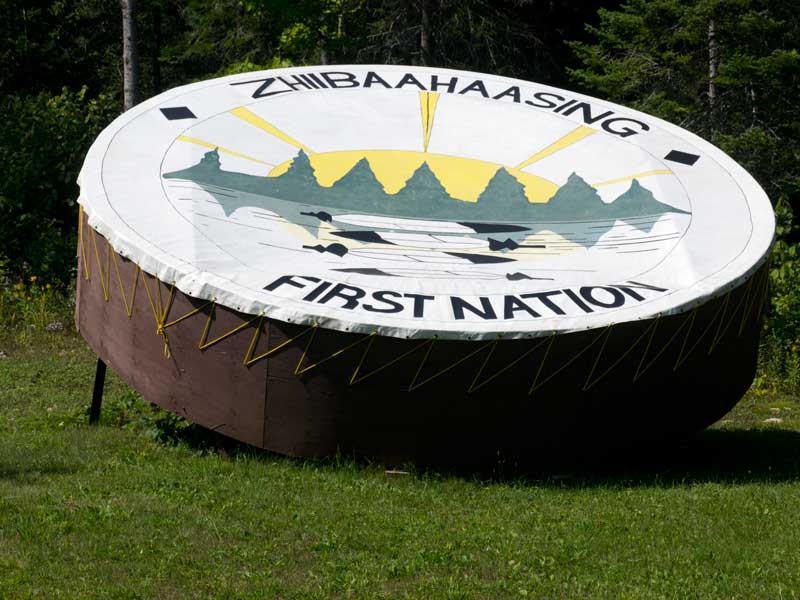The Recorder
BARRIE ISLAND—Work began late last week to eradicate a very large swath of phragmites in the Salmon Bay area of Barrie Island.
“This is a large patch (of phragmites),” said Judith Jones of the Manitoulin Phragmites Project who, along with local residents and cottagers, carried out the work to begin removing the phragmites from the bay.
The swath in what is known as Salmon Bay, near the Bruce Summers property on Barrie Island, was found and reported by Harold and Pam Hergott of Goosegap Cresent. “We spotted this invasive plant, phragmites in 2018, which led to contacting phragmites expert Judith Jones for a solution and path forward.” Ms. Jones’ immense knowledge and background experience on this plant led Anne Foley and Mr. and Mrs. Hergott to organize a work crew to aid Judith and her crew of cutters to tackle this daunting task.
Ms. Hergott explained, “we do a lot of kayaking and fishing in the bay, and one day we were out fishing and I said, ‘that doesn’t look like natural regrowth’,” said Ms. Hergott. “Phragmites can form patches that are five metres tall and so dense and compact that fish and wildlife can’t get through it.”
Permission had been granted by Bruce Summers to the Hergotts to go on their property for the work to begin.
“Last year we carried out work on phragmites in 54 sites on Manitoulin Island,” said Ms. Jones. She said that it is imperative that people who see phragmites contact the Manitoulin Phragmites Project team.
The large phragmites swath in Salmon Bay is about four metres in height, it was pointed out.
“Phragmites spreads by pieces of the plant being spread around,” said Ms. Jones. She advised people should always clean machinery such as ATVs, snow machines and boats before leaving their yard.
The Manitoulin Phragmites Project group will be holding Manitoulin Phragmites Education Week from July 20 to 25, “where we will be showing people how to get rid of them. The whole schedule of where they will be holding sessions is on the Manitoulin Phragmites Project website.”
“We’ve had really good success with the project; the whole south shore of Manitoulin has been pretty well cleared of phragmites and we have more work to be done at Blue Jay Creek, Burnt Island and at the top of South Bay (on the Wiikwemkoong side) that needs to be completed,” said Ms. Jones.
Phragmites also called European common reed, is a very tall, robust grass that spreads aggressively on beaches, shores and in shallow water. It can grow to five metres tall and form patches so dense that turtles can’t crawl to the sand, ducks can’t nest on the shore and people can’t see the lake.
Phragmites kills other vegetation and alters water flow in soil. It can be a serious economic problem if it fills in ditches, drains, and sewage lagoons. It can also reduce the public’s use and enjoyment of the shoreline.
It can grow to up to five metres tall and its stems may be red or green, ridged or smooth. It flowers in mid-to-late August, later than other common grasses. Tall, dead stalks often stay standing for several years in among newer green stems.
The leaf collar on a plant has no membrane or tissue where it clasps the stem.
Why is it a problem? It poisons and eliminates surrounding vegetation, forms dense patches that prevent water flow in soil and wave action on beaches, alters and destroys fish and wildlife habitat, blocks ditches and drains resulting in flooded ground, reduces sightlines on roads, reduces enjoyment of shorelines and causes loss of property value.
Phragmites spreads from pieces of the plant which sprout and form new patches—don’t drive through it! Always clean machinery and ATVs before leaving the yard. Use a hose or a dry brush or broom.
The time to work on phragmites is before any seed heads are present, usually before mid-August.
In standing water: cut stems and runners at the very bottom at the mud or sand. Collect up all pieces including any small fragments that may start new patches.
On damp ground: cutting will not kill the roots. Using a sharp spade, slice into ground at the bottom of stems, and remove stems. Try not to dig up ground, but only slice in the rhizome (root cluster).
On ground with no water in summer: consider a careful application of herbicide by a licensed exterminator trained to work in sensitive environments.
In disposing of phragmites, take care not to drop pieces of phragmites as they may sprout. Tightly bundle long stems with twine and bag small pieces. Transport bundles in a tarp or closed trailer. Leave cut material in a hot, dry place. Once dry, it may be burned or taken to the landfill.
Inspect and clean clothes and vehicles after working around phragmites.
“We’ll never be rid of phragmites,” stated Ms. Jones. “But we can maintain and control it, so there ends up being little maintenance.”





